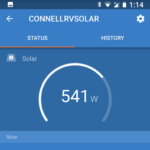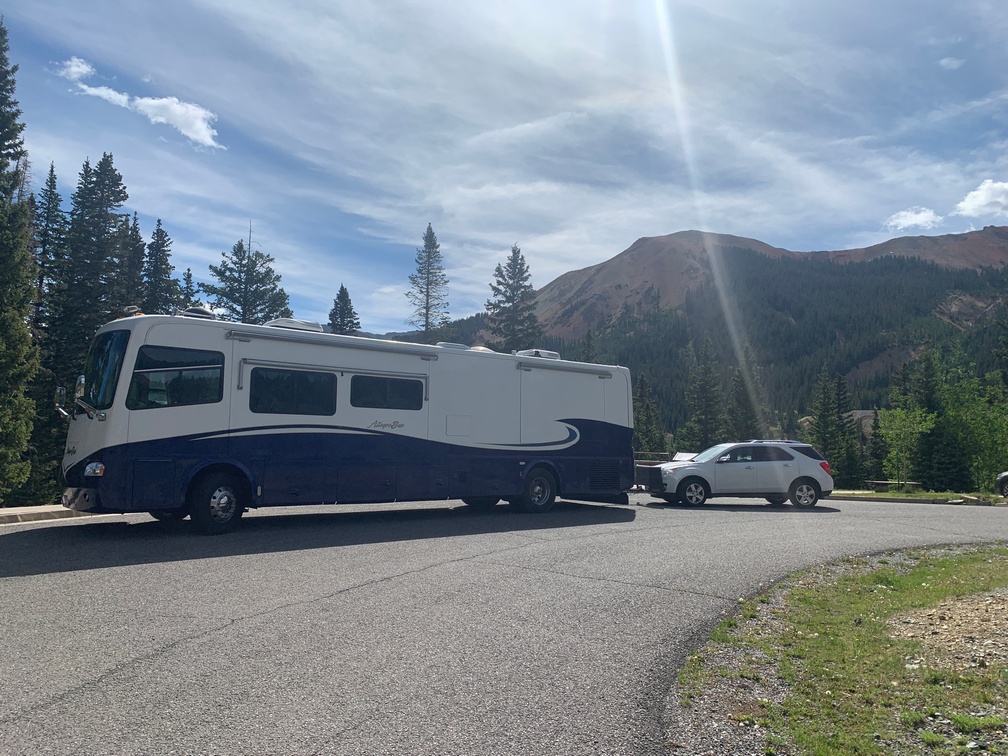Let the testing begin! Our first camping trip after I installed 640 watts of flexible Renogy solar panels and a Victron 100/50 charge controller was at the Albuquerque Balloon Fiesta campground October 3rd till the 14th. We had signed up for an Escapee’s HOP (Head Out Program) late last year when I couldn’t find more than a couple days in a row of available reservations. Turns out they open the Balloon Fiesta Camping reservations up about a week after the last one ends so I was a couple months late to the party. Luckily I found the ad for the HOP and they had a few openings. I reserved a spot right then.
Fast forward ten months and we were camping there with our barely tested new solar panels charging our house batteries. First thing I noticed was around noon the first full day there, they stopped charging the battery. I checked the side compartment with the charge controller and I saw that one of the breakers on the battery side of the controller had tripped. The devices I bought were supposed to be 50 amp breakers, but from what I could tell, it tripped around 30 amps. Not a good sign. I clicked it back on and we started charging again.
I started researching breakers and determined that I probably should have bought 60 amp breakers for that part of the circuit and better quality ones. So I started calling local distributors, but none had them in stock, so I gave up for a bit.
Next day it happened again, the same breaker tripped. I could see this was going to be a chronic problem unless I replaced it. Again I started looking online for a replacement and at the same time wondered where I could have it delivered. After all, I was in a sea of RV’s. No way for UPS to find us.
A few days went by while I called just about every electronic and electrical supply house within 90 miles of Albuquerque. I also kept googling. And then unexpectedly about 30 pages of results later, I found an ad for a 60amp breaker at an unlikely place called Sportsman’s Warehouse. I called their local store, and to my surprise, they had a bunch in stock! That afternoon I drove over and bought one immediately. Turns out they were in the fishing section of the store for trolling motors, MinnKota MKR-19 Circuit Breaker 60A. I replaced the faulty breaker that afternoon.
Of course, once that was in place, the next day the breaker I had previously installed on the negative side of the circuit tripped. I had only put that breaker on there as a switch so I could turn off both the negative and positive sides of the circuit. Humbug! So I went back to the store and bought a second one and installed that on the negative side of the circuit. The issue with these particular breakers for me was no button to trip them manually, which is one of the main reasons I bought the problematic ones. They had a button to press to trip them, so in effect they were also a switch. I had seen other solar install pictures online where those same cheap breakers were used for solar hookups, so I figured they would work. Geez, was that a wrong assumption.
By now we are just a couple days from the end of the fiesta, so I decided to shop for one online that had the manual trip lever to install prior to us leaving for our next trip. I eventually pulled the trigger on the Bussmann CB185-60 breaker and had it shipped to the house once we arrived back home. I will be leaving the MinnKota on the other side of the circuit till I can find a suitable surface mount switch.
Now that I was no longer tripping breakers, I could really see  what the panels were capable of. One of the days I happened to look at the console and see over 540 watts of power being generated and almost 40 amps going to the batteries. That was pretty amazing because the panels are flat mounted on the RV roof and the sun was getting low in the sky as it’s the middle of October. Solar panels should be angled toward the sun for optimum production, but I decided early on in my research that I wasn’t climbing up on the roof to tilt them up and put them down each time we moved. Once I committed to flexible panels that was fairly moot anyway.
what the panels were capable of. One of the days I happened to look at the console and see over 540 watts of power being generated and almost 40 amps going to the batteries. That was pretty amazing because the panels are flat mounted on the RV roof and the sun was getting low in the sky as it’s the middle of October. Solar panels should be angled toward the sun for optimum production, but I decided early on in my research that I wasn’t climbing up on the roof to tilt them up and put them down each time we moved. Once I committed to flexible panels that was fairly moot anyway.
While we were there, I experimented using the generator in the morning to charge the batteries up to around 80% SOC (state of charge), which is around the point the onboard charger drops out of bulk charging mode. At that point I shut the generator down to let the solar panels attempt to top the batteries off during the rest of the sunny day. Only using the generator while the charger is in bulk mode should be the most efficient use of the diesel generator. Once the charging switches from bulk into the absorb charging mode, the charge amperage drops fairly quickly. Even when the charger is only pushing 10 amps into the batteries, the generator seems to be under the same load as when it’s charging them at 125 amps in bulk.
I am now starting to more fully understand the difficulty of fully charging our batteries via solar . Adding more panels will help, but in reality I probably can’t fit enough panels on the roof of my RV to get it done in the middle of winter.
The chemistry of batteries prevent them accepting the full amperage of the panels once they get above 80% charged state where the controller shifts into absorption mode. More panels will get you to 80% quicker, but then the battery chemistry kicks in and effectively starts pushing back and the controller starts dropping the amperage going to them. So if you calculated you could push 40 amps for 4-6 hours of the day (240 AH) and less AH before and after those hours, then in theory I figured we can push all those AH into the batteries during those six hours, but that’s not reality. As soon as those batteries hit around 80% SOC, the amount of charge accepted quickly drops. So if your batteries are depleted below 80% SOC, say at 60% SOC, you can really push in those amps for a while; but when they hit that 80% threshold, the amps drop, and they drop in an almost linear line down to just a few amps and then hit float charging.
My experiment running the generator in the morning was my charge controller switched from bulk charging to float charging way too quickly, almost no time was spent in the absorb phase of charging from the panels, which should be the bread and butter of solar. I started to search for an answer to that, and what I found out so far was the amount of time the charge controller stays in absorb is determined by the voltage the charge controller sees when it wakes up due to first sunlight in the morning. The higher the voltage it sees when it wakes up, the shorter the time it stays in the absorb phase; and the generator made the controller see much higher voltage when it woke up, so the absorption time was cut to almost nothing.
But that was learned a bit too late in the game, so this will continue when we dry camp in Quartzsite the middle of January.
